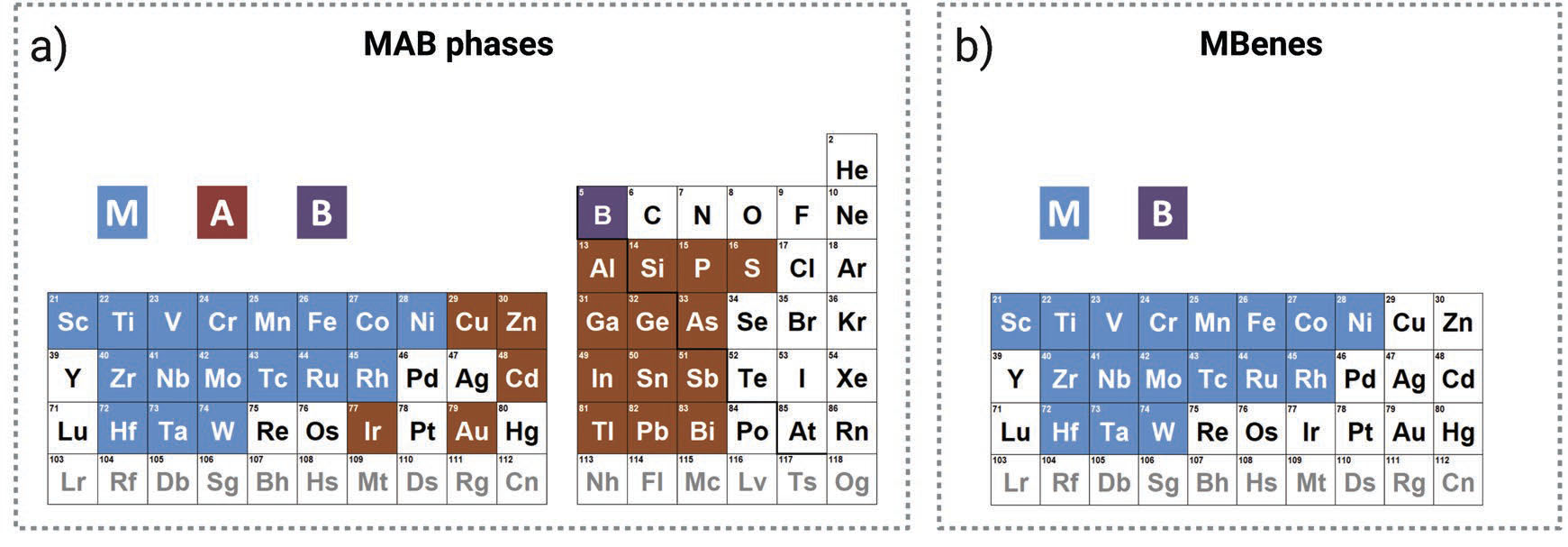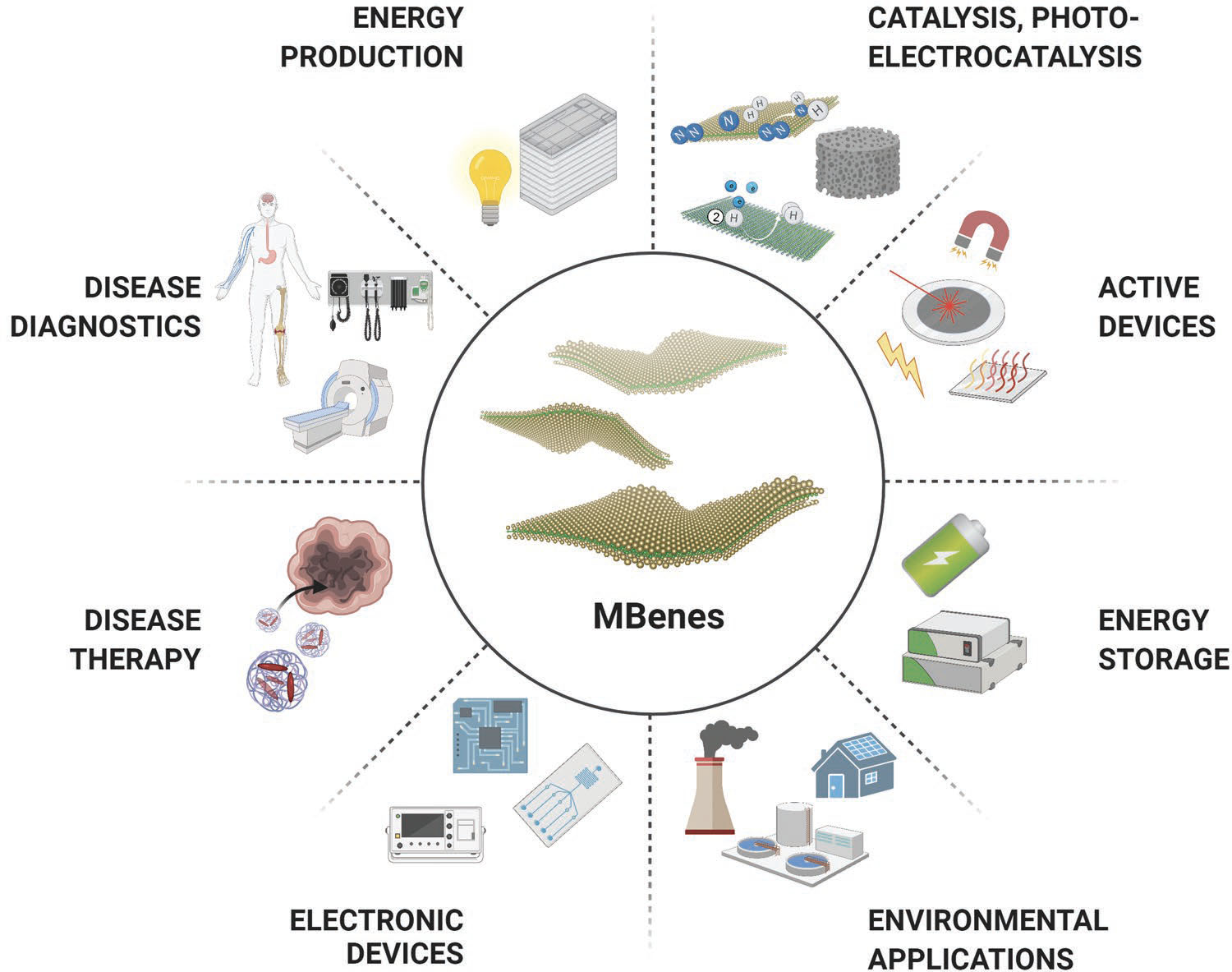| May 26, 2022 | |
A new member in flatland - MBenes awaiting successful synthesis |
|
| (Nanowerk Spotlight) Pure crystalline boron is a semiconductor – it conducts electricity like a metal at high temperatures – and is almost an insulator at low temperatures. Decades of research on transition metal borides (TMBs) and their phases have led to a novel class of 2D transition metal borides termed MBenes – the boron-analogues of MXenes. | |
| Similar to the MAX phases in the context of MXenes, researchers have coined the term 'MAB phases' for MBenes. MAB phases are usually composed of an early transition metal (M), metals from groups 13 and 14 of the periodic table (A), and boron (B), having variable structures and stoichiometries. Based upon MAB phases, their corresponding 2D counterparts (MBenes) are composed of M and B, but different lattice symmetries clearly differentiate them from MXenes with Mn+1Xn stoichiometry, and only hexagonal lattices are observed for MXenes. | |
 |
|
| MBenes’ possible compositions and structures. The variety of elements from the periodic table to be used to compose a) MAB phases and b) MBenes. (Reprinted with permission from Wiley-VCH Verlag) | |
| A recent Perspective article in Advanced Materials ("2D MBenes: A Novel Member in the Flatland") comprehensively summarizes the current knowledge of MBenes regarding their atomic structure/arrangement, synthesis routes, prospective properties, and potential applications. | |
| The authors emphasize that the majority of theoretical predictions considering these 2D materials are based on ab initio approaches in the framework of density functional theory (DFT), which is one of the most powerful techniques to obtain reliable, accurate predictions of a variety of material properties. Consequently, the theoretical predictions presented in this Perspective are entirely based on DFT, and should be understood as a motivation for further post-DFT studies and experimental studies on these exciting 2D materials. | |
| Due to the very early stage of development, little is known about MBenes' physical and chemical properties, although excellent mechanical, electronic, metallic/semiconducting, capacitive, and thermoelectric properties have been theoretically predicted for them. | |
| However, even the most accurate theoretical predictions and optimistic predictions demonstrating MBenes' outstanding physical properties cannot be realized if researchers are not able to experimentally synthesize them – something the research community still is waiting for. | |
| High-throughput screening based upon DFT calculations allowed for the prediction of MBenes' mechanical properties, which appear to be comparable to and even superior with respect to other 2D nanomaterials. Furthermore, MBenes are expected to have excellent catalytic properties as determined by their chemical composition, metallic properties, and negligible hydrogen adsorption. | |
| Other aspects of MBenes worth mentioning are their their magnetic properties since they are important for their potential application in data storage, water purification, energy generation, and biomedicine. | |
 |
|
| Schematic illustration of MBenes' wide range of potential applications. (Reprinted with permission from Wiley-VCH Verlag) | |
| The authors foresee that overcoming the synthesis bottlenecks will enable a rational control over MBenes' properties. "Further development of post-processing approaches will open a door for designing new functional structures with extraordinary stability, strength, conductivity, transition properties, and energy-harvesting properties," they conclude. "These may be used for designing promising next-generation devices for application in spintronics, HER, NRR, OER, ORR, energy production and storage, or even in various biomedical fields." | |
 By
Michael
Berger
– Michael is author of three books by the Royal Society of Chemistry:
Nano-Society: Pushing the Boundaries of Technology,
Nanotechnology: The Future is Tiny, and
Nanoengineering: The Skills and Tools Making Technology Invisible
Copyright ©
Nanowerk LLC
By
Michael
Berger
– Michael is author of three books by the Royal Society of Chemistry:
Nano-Society: Pushing the Boundaries of Technology,
Nanotechnology: The Future is Tiny, and
Nanoengineering: The Skills and Tools Making Technology Invisible
Copyright ©
Nanowerk LLC
|
|
|
Become a Spotlight guest author! Join our large and growing group of guest contributors. Have you just published a scientific paper or have other exciting developments to share with the nanotechnology community? Here is how to publish on nanowerk.com. |
|
